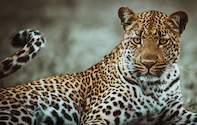
How big is a Leopard?
The leopard is a graceful animal with an elongated body, relatively short legs and a long tail. After the lion, the leopard is the next-biggest African cat with an average body mass of between 60kg and 70kg, standing about two-thirds of a metre tall at the shoulder.
How long do Leopards live?
Leopards in the wild may live up to 15 years. Unlike the lion, the leopard is a silent creature, only occasionally emitting a cough-like call.
How do Leopards hunt?
The leopard's hunting technique is to either ambush its prey or to stalk it. In either instance, it tries to get as close as possible to its target. It then makes a brief and explosive charge (up to 60km/h), pouncing on its prey and dispatching it with a bite to the neck. Leopards do not have the aptitude to chase their quarry over any kind of distance and will give up if the initial element of surprise is lost and the intended victim gets away.

What Does a Leopard Eat?
Leopards eat a variety of food, from wildebeest to fish, but most of their diet comes in the form of antelope.
How much weight can a Leopard carry up a tree?
Leopards are capable of carrying animals heavier than themselves and will often drag their prey into the fork of a tree several metres off the ground. This tree "lardering" protects the carcass against scavengers and allows a few days of undisturbed feeding.
Researchers believe that each individual leopard accounts for approximately 20 kills a year. Leopards eat on average about a third of the carcass of the animal they kill and this works out at roughly 400kg of meat per leopard each year. This means that leopards probably need just over a kilogram of meat a day. A leopard will often lick the fur off the carcass of its prey before it feeds, starting with the thighs or the chest.

Leopard Facts
Leopards are highly adaptable creatures, capable of living in semi-desert conditions as well as dense subtropical bush. Their territories can also vary in size from 10 square kilometres, to several hundred square kilometres. Leopards scratch trees and use urine to mark their turf. A male leopard will defend his territory against other males, but will share territory with females.
Baboons and leopards appear to be ancient enemies. Leopards will often stalk baboons sleeping in the trees at night, and try to carry off one of the troop. There has been a case recorded in which a leopard that tried to attack a baboon in broad daylight was torn to pieces by the rest of the troop, which quickly came to the shrieking primate's defence.
Male and female leopards spend only a brief time together while they are mating and then go their separate ways. The female will then raise the cubs on her own. Leopards can survive for long periods without drinking, satisfying all their moisture needs from their prey.
Ever wondered what eats Leopards?
On occasion, Lions have been known to hunt and kill leopards.

Best Place to See Leopards
While leopards can be quite elusive - there are some areas where you are more likely to spot one of these stunning creatures.
What is the best place to see leopard in Kruger Park?
Simbambili Game Lodge in the northern part of Sabi Sand Game Reserve is known for its many leopard sightings.
Stay at Simbambili Game Lodge

Learn More About The Difference Between Leopard and Cheetah
Leopard

Physique: Robustly built with more powerful appearance; bigger head and more muscular limbs
Markings: Bigger rosettes rather than spots; no "tear mark" stripes down the face
Hunting techniques: Ambush or stalk prey, pouncing when close enough
Claws: Retractable Tail: Shorter
Habitat: Dense bush and wooded koppies
Cheetah

Physique: Slender build with small head and an elongated body; slightly dog-like appearance
Markings: Smaller spots; distinctive "tear lines" down either side of the nose
Hunting techniques: Stalk prey and then make a 60m to 100m charge, knocking the fleeing animal off balance
Claws: Retractable as a cub but non-retractable as an adult
Tail: Longer, heavier
Habitat: Open savanna

